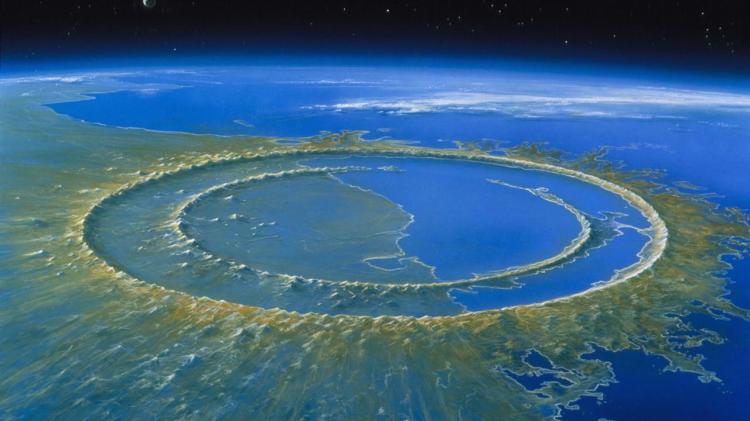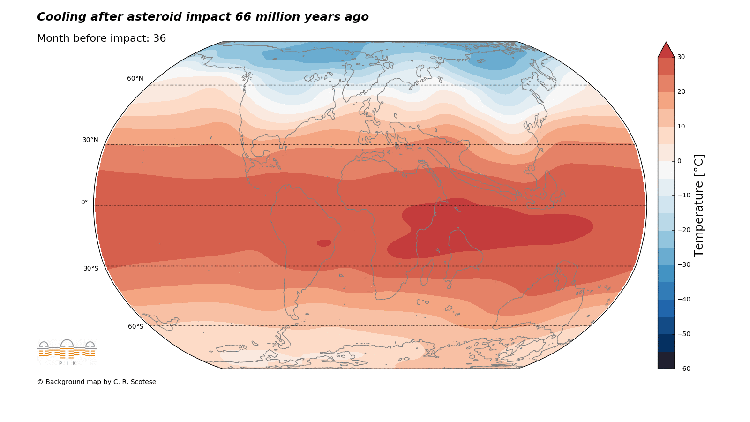
Artist’s reconstruction of Chicxulub crater 66 million years ago.
About thirty years ago, the discovery of anomalously high abundance of iridium and other platinum group elements in the Cretaceous/Palaeogene (K-Pg) boundary led to the hypothesis that a 10 km asteroid collided with the Earth and caused one of the most devastating events in the history of life. The impact created the 180-kilometre wide Chicxulub crater causing widespread tsunamis along the coastal zones of the surrounding oceans and released an estimated energy equivalent of 100 teratons of TNT and produced high concentrations of dust, soot, and sulfate aerosols in the atmosphere.
To model the climatic effects of the impact, a team of scientist from the Potsdam Institute for Climate Impact Research (PIK), use literature information from geophysical impact modeling indicating that for a 2.9 km thick target region consisting of 30% evaporites and 70% water-saturated carbonates and a dunite projectile with 50% porosity, a velocity of 20 km/s and a diameter between 15 and 20 km, a sulfur mass of 100 Gt is produced. This is about 10,000 times the amount of sulfur released during the 1991 Pinatubo eruption. Additionally, for a sulfur mass of 100 Gt, about 1400 Gt of carbon dioxide are injected into the atmosphere, corresponding to an increase of the atmospheric CO2 concentration by 180 ppm. There could be additional CO2 emissions from ocean outgassing and perturbations of the terrestrial biosphere, adding a total of 360 ppm and 540 ppm of CO2. The main result is a severe and persistent global cooling in the decades after the impact. Global annual mean temperatures over land dropped to -32C in the coldest year and continental temperatures in the tropics reaching a mere -22C. This model is supported by a migration of cool, boreal dinoflagellate species into the subtropic Tethyan realm directly across the K–Pg boundary interval and the ingression of boreal benthic foraminifera into the deeper parts of the Tethys Ocean, interpreted to reflect millennial timescale changes in the ocean circulation after the impact (Vellekoop, 2014).

A time-lapse animation showing severe cooling due to sulfate aerosols from the Chicxulub asteroid impact 66 million years ago (Credit: PKI)
References:
, , and (2016), Baby, it’s cold outside: Climate model simulations of the effects of the asteroid impact at the end of the Cretaceous, Geophys. Res. Lett., 43, doi:10.1002/2016GL072241.
Alvarez, L. W., W. Alvarez, F. Asaro, and H. V. Michel (1980), Extraterrestrial Cause for the Cretaceous-Tertiary Extinction, Science, 208 (4448), 1095{1108, doi: 10.1126/science.208.4448.1095.
Galeotti, S., H. Brinkhuis, and M. Huber (2004), Records of post Cretaceous-Tertiary boundary millennial-scale cooling from the western Tethys: A smoking gun for the impact-winter hypothesis?, Geology, 32, 529, doi:10.1130/G20439.1
Johan Vellekoop, Appy Sluijs, Jan Smit, Stefan Schouten, Johan W. H. Weijers, Jaap S. Sinningh Damsté, and Henk Brinkhuis, Rapid short-term cooling following the Chicxulub impact at the Cretaceous–Paleogene boundary, PNAS (2014) doi: 10.1073/pnas.1319253111
Pingback: A po dopadu přišel mráz | DinosaurusBlog